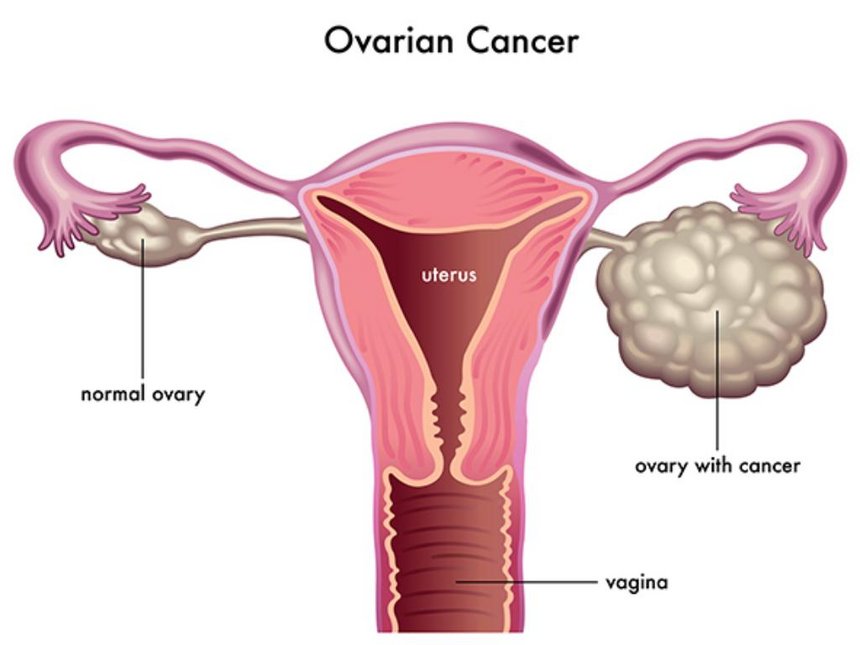OVARIAN CANCER
Ovarian cancer is a type of cancer that begins in the ovaries. Women have two ovaries, one on each side of the uterus. The ovaries — each about the size of an almond produce eggs (ova) as well as the hormones estrogen and progesterone.
Ovarian cancer often goes undetected until it has spread within the pelvis and abdomen. At this late stage, ovarian cancer is more difficult to treat and is frequently fatal. Early-stage ovarian cancer, in which the disease is confined to the ovary, is more likely to be treated successfully.
DISEASE OCCURRENCE IN POPULATION
Ovarian cancer is the leading cause of death from gynecologic malignancy in the United States. In the United States each year, there are approximately 22,000 new cases of ovarian cancer and 14,000 cancer-related deaths. Worldwide, the number of new cases of ovarian cancer each year is approaching 250,000. It is the seventh most common cancer in women, and incidence rates are highest in developed countries. The incidence of ovarian cancer increases with age.
In Pakistan, ovarian cancer is the 4th most common malignancy in women. It is the most common cancer of gynecologic origin.

RISK FACTORS
Factors that can increase your risk of ovarian cancer include:
- Older age: Ovarian cancer can occur at any age but is most common in women ages 50 to 60 years.
- Inherited gene mutations: A small percentage of ovarian cancers are caused by gene mutations you inherit from your parents. The genes known to increase the risk of ovarian cancer are called breast cancer gene 1 (BRCA1) and breast cancer gene 2 (BRCA2). These genes also increase the risk of breast cancer.
- Other gene mutations, including those associated with Lynch syndrome, are known to increase the risk of ovarian cancer.
- Family history of ovarian cancer: People with two or more close relatives with ovarian cancer have an increased risk of the disease.
- Estrogen hormone replacement therapy, especially with long-term use and in large doses.
Age when menstruation started and ended: Beginning menstruation at an early age or starting menopause at a later age, or both, may increase the risk of ovarian cancer.
SIGN AND SYMPTOMS
Ovarian cancer symptoms are often vague. By the time the cancer is diagnosed, the tumor has often spread beyond the ovaries.
You should see your doctor if you have the following symptoms on a daily basis for more than a few weeks:
- Bloating
- Difficulty eating or feeling full quickly
- Pelvic or abdominal pain
Other symptoms are also seen with ovarian cancer. However, these symptoms are also common in women who do not have cancer:
- Abnormal menstrual cycles
- Constipation
- Increased gas
- Indigestion
- Lack of appetite
- Nausea and vomiting
- Sense of pelvic heaviness
- Swollen abdomen or belly
- Unexplained back pain that worsens over time
- Vaginal bleeding
- Vague lower abdominal discomfort
- Weight gain or loss
Other symptoms that can occur with this disease:
- Excessive hair growth
- Increased urinary frequency or urgency
DIAGNOSIS
Tests and procedures used to diagnose ovarian cancer include:
Pelvic exam: During a pelvic exam, your doctor inserts gloved fingers into your vagina and simultaneously presses a hand on your abdomen in order to feel (palpate) your pelvic organs. The doctor also visually examines your external genitalia, vagina and cervix.
Imaging tests: Tests, such as ultrasound or CT scans of your abdomen and pelvis, may help determine the size, shape and structure of your ovaries.
Blood tests: Blood tests might include organ function tests that can help determine your overall health.
Your doctor might also test your blood for tumor markers that indicate ovarian cancer. For example, a cancer antigen (CA) 125 test can detect a protein that’s often found on the surface of ovarian cancer cells. These tests can’t tell your doctor whether you have cancer, but may give clues about your diagnosis and prognosis.
Surgery: Sometimes your doctor can’t be certain of your diagnosis until you undergo surgery to remove an ovary and have it tested for signs of cancer.
Once it’s confirmed that you have ovarian cancer, your doctor will use information from your tests and procedures to assign your cancer a stage. The stages of ovarian cancer are indicated using Roman numerals ranging from I to IV, with the lowest stage indicating that the cancer is confined to the ovaries. By stage IV, the cancer has spread to distant areas of the body.
TREATMENT
Operations to remove ovarian cancer include:
Surgery to remove one ovary: For very early stage cancer that hasn’t spread beyond one ovary, surgery may involve removing the affected ovary and its fallopian tube. This procedure may preserve your ability to have children.
Surgery to remove both ovaries: If cancer is present in both your ovaries, but there are no signs of additional cancer, your surgeon may remove both ovaries and both fallopian tubes. This procedure leaves your uterus intact, so you may still be able to become pregnant using your own frozen embryos or eggs or with eggs from a donor.
Surgery to remove both ovaries and the uterus: If your cancer is more extensive or if you don’t wish to preserve your ability to have children, your surgeon will remove the ovaries, the fallopian tubes, the uterus, nearby lymph nodes and a fold of fatty abdominal tissue (omentum).
Surgery for advanced cancer: If your cancer is advanced, your doctor may recommend chemotherapy followed by surgery to remove as much of the cancer as possible.
Chemotherapy
Chemotherapy is a drug treatment that uses chemicals to kill fast-growing cells in the body, including cancer cells. Chemotherapy drugs can be injected into a vein or taken by mouth. Sometimes the drugs are injected directly into the abdomen (intraperitoneal chemotherapy).
Chemotherapy is often used after surgery to kill any cancer cells that might remain. It can also be used before surgery.
Targeted therapy
Targeted therapy uses medications that target the specific vulnerabilities present within your cancer cells. Targeted therapy drugs are usually reserved for treating ovarian cancer that returns after initial treatment or cancer that resists other treatments. Your doctor may test your cancer cells to determine which targeted therapy is most likely to have an effect on your cancer.
Targeted therapy is an active area of cancer research. Many clinical trials are testing new targeted therapies.
Supportive (palliative) care
Palliative care is specialized medical care that focuses on providing relief from pain and other symptoms of a serious illness. Palliative care specialists work with you, your family and your other doctors to provide an extra layer of support that complements your ongoing care. Palliative care can be used while undergoing other aggressive treatments, such as surgery and chemotherapy.
When palliative care is used along with all of the other appropriate treatments, people with cancer may feel better and live longer.
Palliative care is provided by a team of doctors, nurses and other specially trained professionals. Palliative care teams aim to improve the quality of life for people with cancer and their families. This form of care is offered alongside curative or other treatments you may be receiving.
PRECAUTIONS
There’s no sure way to prevent ovarian cancer. But certain factors are associated with lower risk:
- Use of oral contraceptives, especially for more than 10 years
- Previous pregnancy
- History of breast-feeding
- Daily use of aspirin.
- Having fallopian tubes tied (tubal ligation)
- Surgical removal of some female reproductive organs, such as the uterus or fallopian tubes.
REFERENCE
- Siegel RL, Miller KD, Jemal A. Cancer statistics, 2018. CA Cancer J Clin 2018; 68:7.
- US Preventive Services Task Force, Grossman DC, Curry SJ, et al. Screening for Ovarian Cancer: US Preventive Services Task Force Recommendation Statement. JAMA 2018; 319:588.
- World cancer research fund international. Cancer facts and figures. http://www.wcrf.org/int/cancer-facts-figures/worldwide-data (Accessed on April 17, 2017).
- Malik 1, Khan W, Khan Z. Pattern of malignant tumors observed in a University hospital: A retrospective analysis. J. l’ak. Med. Assoc., 1998;48: 120-122.
- Bhurgri Y, Bhurgri A, Hassan SH, et at. Cancer incidence in Karachi, Pakistan: first results from Karachi Cancer Registry Int. J. Cancer, 2000;85:325-29.
- https://www.mayoclinic.org/diseases-conditions/ovarian-cancer/symptoms-causes/syc-20375941
- http://www.cancer.net/cancer-types/ovarian-cancer/risk-factors-and-prevention
